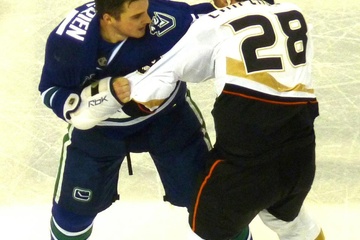“We have talked a bit about the vulva, which makes me kind of feel uncomfortable,” says Mason S. Hsieh ’15, chuckling with a mixture of boyish embarrassment and self-deprecation. “I don’t have one,” he continues, “but you know, it’s kind of theoretically fun.”
Such is the ostensible plight of the male enrollee in Anthropology 1882: “The Woman and the Body,” a course title that likely evokes horrifying anatomical analysis and indignant feminist angst in the male mind.
That “cult of the feminine” image is a far cry from the hospitable environment Susan Greenhalgh, a professor of Anthropology, establishes in class. Despite its alleged lecture format, the course often feels far more like a large-scale seminar, with Greenhalgh requesting not only theoretical analysis, but also personal commentary from her students. Her openness encourages the class to draw on their own experiences as they engage with the material. When two images of Serena Williams project on the screen, 10 hands shoot up, and the room fills with the women’s testimonies on athletic feminization.
The male students, four out of 83 this semester, are far from mute acolytes. Three comment over the course of an hour, one citing a female family member, another challenging the claim that shopping functions as a unifying experience. To do so, he speaks of the sartorial history he shares with his father.
Indeed, many female students find a male lens on this material critical. Helen C. Clark ’15, who took the course last year when there were no male enrollees, notes how a different perspective can break women out of their “bubble of awareness,” highlighting which concepts men find alienating.
Greenhalgh cites males as some of her most frequent contributors. Both Hsieh and Nathan H. Pointer ’15, another male student in the class, say they feel empowered rather than burdened to represent a male lens. Such a focus runs the risk of essentializing them, but their tendencies to speak from the first person and even resist expected masculine perspectives belies that claim.
Empowerment, beloved contribution, and wonderful male-female ratios create a delightful ambiance to be sure. But these brave men must have little connection to the material. Cue vulva slide.
However, lectures range across many topics that are pertinent to both genders. For example, Greenhalgh leads discussions about non-gendered Foucaultian power theories and the definition of “biocitizenship,” a gender-neutral term denoting the moral and productive member of society as both healthy and policing the health of others.
Greenhalgh’s course may be founded on feminist theory, but a shifting cultural discourse on the “obesity epidemic” in America has increased its relevance to men.
On the disconnect between this pertinence and male enrollment, Pointer says, “Everyone can relate to this kind of material. What’s disappointing is that once you enter the WGS department not many people do. It’s mostly women. Well, it’s women and sexual minorities, honestly.”
While Anthro 1882 is not actually housed within the WGS department, these isolating concerns ring true here as well. Men who take the course and others like it tend to already identify as feminists or allies. Greenhalgh notes that all the male students she has spoken to in “The Woman and the Body” have been gay. While understanding gender power structures is, of course, edifying to such communities, the class runs the risk of preaching to the choir. Presumably, the population that could benefit the most from this material, both personally and societally, is that of heterosexual males.
“I think that’s one of the main points of WGS: How do you disseminate that information?” says Pointer, though he, like many others, seems unsure of how to achieve such an end, except to allow the nascent course to grow in notoriety and popularity.
One potential route may involve emphasizing how gender dynamics are critically interlaced with other domains such as race and class. As Greenhalgh points out, “These are postmodern times when our understandings are far more fluid and contingent.”


